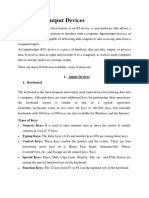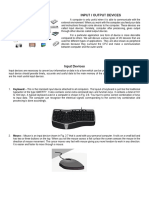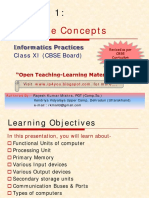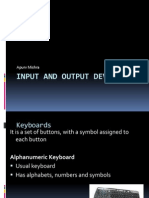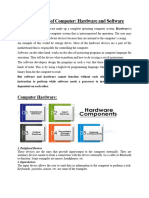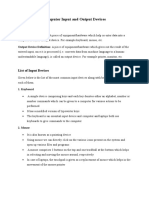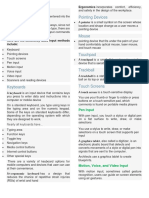0 ratings 0% found this document useful (0 votes) 260 views 5 pages 2.input and Output Device
The document provides an overview of input and output devices used in computing, detailing various types of input devices such as keyboards, mice, and scanners, as well as output devices like monitors and printers. It explains the functionality and applications of each device, highlighting their importance in data processing and user interaction. Additionally, the document covers input-output modules and includes exercises to reinforce understanding of the material.
AI-enhanced title and description
Copyright
© © All Rights Reserved
We take content rights seriously. If you suspect this is your content,
claim it here .
Available Formats
Download as PDF or read online on Scribd
Go to previous items Go to next items
Save 2.Input and Output Device For Later Ma
Chapter ¢
Input and Output Devices
Input Devices
An input device is an extemal hardware device
connected to computer that accepts data and instructions
by the user and tums it into a pattern of electrical signal
in binary code understandable to computer.
‘Some of the input devices are explained as follows :
4. Keyboard
It is the most commonly and very popularly used input
device which uses an arrangement of keys. Both data
and program can be entered into the computer through
the keyboard.
The layout of keyboard is almost identical to traditional,
typewriter with additional keys that help in performing
specific tasks, A normal keyboard usually has a variety
of keys such as alphabetic character keys, function keys,
number keys, arrows keys and control keys, there is no
specific rule for defining the number of keys.
Itis connected to computer using USB (for a wired
keyboard) or bluetooth (for a wireless keyboard). Itis an
essential device for interactive processing because the
user can easily issue commands to receive the data
response immediately on the computer screen,
2. Mouse
The mouse is the most common and very popular
pointing device that allows to control the movement of
pointer /cursor (also known as mouse pointer) on screen
and click on the corresponding objects using its button
i, It works on point and click concept.
Mouse performs various functions by detecting two-
dimensional motion relatively to its supporting surface.
‘A mouse can be of different types like wired mouse,
wireless mouse, optical mouse, mechanical mouse etc.
Generally a mouse have two buttons ~ a right button
anda left button.
The left button helps select items while the right button
displays menus.
SF @
Wired mouse Wireless mouse
Mouse also include a scroll wheel between the buttons
to scroll down the application window and their contents
also.
3. Joystick
Itis also a pointing device like the mouse, which consists
ofa stick that pivots on a spherical ball on its base. A
joystick is similar to a mouse excepts that the moment of
cursor on screen stops working as soon as user stop
moving the mouse.
But with a joystick, the pointer continuous moving in the
previously pointing direction. It can be a standalone
device or can be included with multiple buttons and
triggers to add options to perform more in game
features.
Commonly, joysticks are used for playing computer
games like flight simulators but occasionally used for
CAD/CAM systems and other applications.
Some joysticks also have a third degree of freedom, ie.
the stick can be twisted in clockwise or anti-clockwise
direction.
4. Light Pen
It is a pointing device shaped like a pen and is connected
toa Visual Display Unit (VDU). The tip of the light pen
contains light-sensitive element which, when placed.
against the screen, detects the light from the screen
enabling the computer to identify the location of the tip
of pen on screen�Computer Concepts Input and Output Devices
itis mainly used to select on screen items, draw pictures
and write independently in document file using
computer screen,
5. Graphics Tablet
A graphics tablet (or digitisers, digitising tablet, touch
tublets or simply tablet) is an input device that consists
of an electronic writing area and a special pen (called
stylus) that works with it. It allows artists to create
hand-made images and graphical images with motion and
action, similar to the way a person draws images with
pencil and paper.
‘The pen of the graphics tablet is
pressure sensitive, so pressing
harder or softer can result in
brush strokes of different width.
When user draws anything on.
the tablet with the special pen,
the drawing appears on the
screen. It can also be used to signature or texts as and
written text or computer typed text.
6. Touch Screen
It is an electronic visual display that can detect the
presence and location of a touch within the display area.
‘The term touch screen generally refers to touching the
display of the device with a finger.
The touch screen sends a signal to
the computer. This signal gives the
location on the screen, which has
been touched. Touch screen is
quick and simple to use.
Generally, smartphones have a
high-resolution capacitive touch
screen.
There are different types of touch screens available with
electronic devices like capacitive touch screen, resistive
touch screen and gorilla glass touch screen ete.
7. Scanner
Itis a device that allows a user to take an image or text
and converts it into a digital file, allowing the computer
to read or display the scanned object. It is mainly used
to convert a scanned document in a digital format.
8, MICR (Magnetic Ink Character Recognition)
It is a character recognition technology which is
primarily used by the banking industry to facilitate the
processing of cheques. This technology allows the
‘computers to read information (such as account
numbers) on printed documents.
Characters are printed in special typefaces with a
magnetic ink (that contains iron oxide). MICR can read
upto 2400 documents/min.
9. OCR (Optical Character Recognition)
It is used to translate scanned images of handwritten,
type-written, printed text or special type font printed on
conventional paper with conventional ink into machine-
encoded text.
Itis widely used to convert books and documents into
electronic files, to computerise a record keeping system in
an office or to publish the text on a website. An optical
reader uses photoelectric devices to scan the characters
being read and converts the reflected light patterns of the
data into binary data suitable for computer input.
10. OMR (Optical Mark Reader)
Itis used to capture human marked data from document
form such as surveys and tests. One of the most familiar
application of optical mark reader is the checking of
‘optical answer sheets in multiple choice questions. It uses
high intensity to read the marks or symbols.
11. Web Camera (Webcam)
Webcam is a digital video camera attached to computers
and can be used for video conferencing or online chat
etc. It is a video capturing device. Webcams are able to
capture full motion videos as well.
‘A webcam connected to a computer allows the user to
view either a still picture or motion video of a user or
other object. Now-a-days, webcams are either embedded
into the display with laptops or connected via USB or
firewire port or wi-fi to the computer system. After
connecting webcam to a computer, you need to install
required software or drivers.
12. Card Reader
A card reader is a data input device that reads data from a
card-shaped storage medium. The first were punched
card readers, which reads the paper or cardboard.
punched cards that were used during the first several
decades of the computer industry to store information
and programs for computer systems.
‘Modern card readers are electronic devices that can read
plastic cards embedded with either a barcode, magnetic
strip, computer chip or another storage medium,
Output Devices
‘An output device is a part of computer hardware
equipment, used to communicate the results of data
processing which are carried out by an information�)
Processing system (such as a computer), to the outside
world. Output devices carry the results of various
operations performed by the user.
Some of the devices, which are used to display the processed
result or output are as follows
1. Monitor
A monitor (called a visual display unit) is an electronic
device used to display the output. The rectangular area
of the monitor, its tefresh rate and dot pitch, all directly
affect the resolution of the display.
Resolution refers to the clarity of screen and measured
by the number of individual tiny coloured dots (known
as pixels), scattered on the screen. Resolution indicates
the number of dots per inch. The smaller the dot pitch is,
the better the resolution will be.
2. Printer
A printer is an output device, which produces a hard
copy of documents that are stored in an electronic form
‘on physical print media such as paper or transparencies.
So, printers are the primary output devices used to
prepare permanent documents. The speed of a printer is
normally rated either by Pages Per Minute (PPM) or by
Characters Per Second (CPS).
Printers can be classified into two broad categories :
(i) Impact Printers Impact printers rely on a forcible
impact to transfer ink to the print media, similar to
the action of a typewriter. There is a mechanical
contact between the paper and the print head. Line
printer, drum printer, daisy wheel printer and dot
‘matrix printer are the types of impact printers.
(i) Non-impact Printers Non-impact printers are
much quieter than impact printers as their printing
heads do not strike the paper. Most non-impact
printers produce dot-matrix patterns. There is no
mechanical contact between the paper and the print
head. These printers are comparatively faster and
produce high quality output. They can be used for
printing text and graphics both in black and white
and coloured, Electromagnetic printer, thermal
printer, electrostatic printer, laser printer and inkjet
printer are the types of non-impact printer.
3, Plotter
Itis an output device similar to a printer that uses a pen,
pencil, marker or other writing tool to make a design.
Plotters are generally used to generate the map of
building and shopping malls.
A plotter is a computer printing device for printing
vector graphics. In the past, plotters were widely used in
Prep Guide MAH-MCA CET
applications such as Computer Aided Design (CAD) and
other print jobs. Though they have generally been
replaced with wide format conventional printers.
4. Speaker
Speaker is an output device that receives the sound in
the form of electric current from the sound card and
converts it into sound format. Speakers are used for
listen to music. Computer speakers (multimedia
speakers) are the speakers, which are attached internally
or externally to a computer system.
5. Headphones
Headphones are a pair of small loudspeakers or less
‘commonly a single speaker, held close to a user's ears
and connected to a signal source such as an audio
amplifier, radio, CD player or portable media player.
They are also known as stereo phones, headsets or
Colioquially cans.
6. Projector
tis an output device, which is used to project information
from a computer onto a large screen, 50 it can be viewed
by a large group of people simultaneously.
Projectors are widely used for classroom training or
conference halls with a large audience. It provides a
temporary output display.
Input-Output Modules
The input-output module (I/O module) is normally
connected to the computer system on one end and one or
more input/output devices on the other.
An I/O module is needed because of
(i) Diversity of I/O devices makes it difficult to include
all the peripheral device logic into CPU.
(i) The data format and word length used by the
peripheral may be quite different than that of aCPU.
Features of 1/0 Module
The features of /O module are as follows =
(i) Itis a mediator between the processor and an I/O
devices.
(ii) It controls the data exchange between the external
devices and the main memory.
(ii) It should not only communicate the information
from CPU to I/O device but it should also
coordinate these two.
(iv) An I/O module provides an interface internal tothe
‘computer which connects it to CPU and main
memory and an interface external to the computet
connecting it to external device or peripheral.�EXERCISES
= Chapter Challenges
4, Which of the following devices is having a highest
priority while assigning interrupts?
(a) Hard disk () Printer
(©) Keyboard (a) Floppy
2. Which key is used in combination with another
key to perform a specific task?
(a) Function (b) Space bar
(©) Arrow (@) Control
BL A/AN sssssssee device is any hardware component
that allows you to enter data and instructions into
a computer.
(a) storage () input
(©) control (@) output
4, The most common method of entering text and
numerical data into a computer system is through
the use of a
(a) plotter (b) scanner
(© printer (4) keyboard
5. In a keyboard, left-right-up-down set of keys
facilitates which among the following functions?
(a) Deleting data or modification
(b) Page scrolling to view a document
(©) Launching Start Menu
(4) Initiating Search and Help
6. Which button is called as middle button used as
third mouse button?
(a) Right button
(b) Scroll wheel
() Touch bar
(d) Light bar
7. Which device of computer operation dispenses
with the use of the keyboard?
(@) Joystick (b) Light pen
(© Mouse (@) Touch
8. Which of the following is an input device used to
enter motion data into computers or other
electronic devices?
@) Plotter
(©) Trackball
(© Monitor
(€) Joystick
). Which of the following is a lever that can be
moved in several directions to control the
movement of an image on a computer monitor or
similar display screen?
(a) MIDI devices
(©) Optical mark reader
(©) Visual display unit
(@) Joystick
10... . is generally used in applications like
ATM, hospitals, airline reservation, etc.
(a) Light pen (b) Touch screen
(©) Joystick (@) Trackball
11, Which one does not related to mobile phone touch
panel sensing methods?
‘A. Finger touch
B. Voice recognition
C. Gloved touch
D. Light transmittance
@B OA @D @c
12, Which of the following device recognises physical
traits of an individual?
(@) Smart card (b) Biometric sensor
(© Barcode (@) MICR
13. Which of the following consists of an electronic
writing area and a special pen that works with it?
(@) Trackball () Plotters
(©) Abacus (€) Graphics tablet
1B. A.cssssoess is used to tead handwritten or printed
text to make a digital image that is stored in
memory.
(a) printer (b) laser beam
(©) scanner (@) touchpad
415, Which of the following could be digital input
devices for computers?
(a) Digital camcorder _(b) Microphone
(6) Scanner (@) All of these
16. The pattern of printed lines on most products are
called
(0) prices (0) OCR
(6) scanners (€) bar codes�Prep Guide MAH-MCA CET
&
17, The OCR is used for the preparation of
{a) electricity bills
(b) insurance premium
(6) telephone bills,
(d) All of the above:
48, External devices such as printers, keyboards and
modems are known as
(@) add on devices
(b) PC expansion slot add-ons
(©) peripherals
(d) special buys
419. After a picture has been taken with a digital
camera and processed appropriately, the actual
print of the picture is considered as
(@) data (©) output
(©) input (d) the process
20. Which of the following printers, are you sure, will
not to use if your objective is to print on multi
carbon forms?
(a) Daisy wheel (b) Dot matrix
(c) Laser (d) Thermal
21. What are the units used to count the speed of a
printer?
(a) CPM (b) DPR
(PPM (@ BIT
22. Which of the following produces high quality
output?
(@) Impact printer (b) Non-impact printer
(c) Plotter (d) Both (a) and (b)
Lo {[2@] 3H] 4@ | so
IL (@) 12, (b) 13. (d) 14. (e) 15. (d)
21. d) 22 by 23, (d) 24. (d) 25. (a)
23. The higher the resolution of a monitor, the
(a) larger the pixels
(b) less clear the screen is
(6) further apart the pixels
(4) closer together the pixels
|. What type of devices are computer speakers or
headphones?
(a) Input/Output
(6) Storage
(©) Software
(d) Output
. The rate at which scanning is repeated in a CRT is
called
(a) refresh rate (b) resolution
(© pitch (d) bandwidth
. Tt is used to produce large drawings or images
such as construction plans, blueprints for
mechnanical object, etc
(a) Printer (b) Plotter
(c) MICR (d) OCR
The «sss format reduces an audio file to about
one-tenth of its original size, while preserving
much of the original quality of the sound.
(a) Doc (b) PNG
© GF (d) MP3
can interpret voice data into words that
can be understood by the computer.
(@) Speech input hardware
(b) Speech recognition software
(©) Word recognition software
(@) Talking software
‘> * Count Your Score
6 b)
16. (d)
26. (b)
z7@ | &% | o@ | ow
7 @ | 1% © | wm | @ ©
a7. @) | 28
